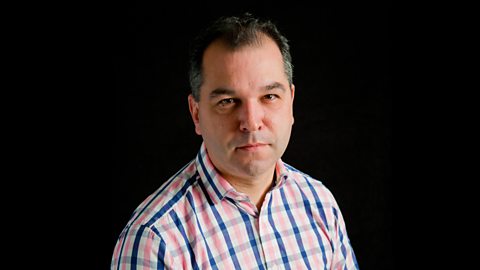Six things we learned about the Nicola Bulley story
In January last year, 45-year-old Nicola Bulley was reported missing. The mystery of her disappearance gripped the nation for three weeks, and speculation over what had happened, amplified by social media, saw journalists and members of the public descend on St Michael’s on the Wyre in Lancashire, where Bulley was last spotted.
The media, police and the public all came in for criticism for how the story was covered, and it raised questions about why some tragedies are highlighted more than others and what role "victim hierarchy" had to play in that.
In this episode of How to read the news, Jo Fidgen digs deep into the reasons behind the public’s obsession with the story and the judgements they might have been making on it. Here are six things we learned about the Nicola Bulley story.
How to Read the News

Listen to How To Read the News. Jo Fidgen explores how the news is made and how our perception of the facts can be shaped by its presentation.

The story of Nicola Bulley went national very quickly
Nicola was reported missing on Friday 27 January, 2023. The police alerted local media the next day and the story appeared in The Mirror and The Mail Online on the Sunday. On the Monday Sky sent a reporter to the village.
Some journalists were critical of the police for not giving "non-reportable briefings" on these issues earlier in the story.
Initially, Northern England ���˿��� News correspondent Danny Savage thought it was a localised missing person news story but the discovery of Bulley’s mobile phone (still connected to a work call) and her dog’s harness near the River Wyre raised the stakes, and he was on the scene by Tuesday.
Social media forced the news agenda
Danny Savage hadn’t expected the story to run beyond key updates, but social media and blog posts set the agenda, growing with each day when there was no sign of Nicola. There were plenty of hooks for people to hang theories on, among them statements by Nicola’s family and friends, searches by a private diving company, and the release of new photographs.
Speaking in a personal capacity, Savage believes that the public could not help themselves. “I think lots of people love a good mystery,” he says, “and there was one happening right in front of them, developing day by day. I think it just sparked the imagination.”
The absence of "non-reportable briefings" may have fuelled the frenzy
Lancashire Police were aware Nicola had health issues with alcohol and the menopause, and released this information a few days before Nicola’s body was found on February 17. The force was subsequently criticised for this in a review by the College of Policing.
Some journalists were critical of the police for not giving "non-reportable briefings" on these issues earlier in the story so as to influence how the story was reported and dampen down speculation.
One complication for the police was new regulations imposed by the Leveson Inquiry on press transparency. Police now have to note down any meeting with the press, and journalists are listed as a corruption risk in police guidance – along with sex offenders, terrorists, criminals and private investigators. “It really does set the tone,” says Rebecca Camber, crime and security editor of the Daily Mail.

Media coverage is impacted by "victim hierarchy"
The level of public interest in Nicola Bulley’s disappearance may have been part of what academics call "victim hierarchy". This phenomenon suggests that public sympathy is predicated on factors such as race, appearance, class and other factors including mental health.
“The more angelic, the more innocent, the pretty white person is likely to get far more coverage than someone with a more complicated life,” says Professor Karen Shalev, director of the Missing Persons Research Group. “In general, we are less compassionate if something bad happens to someone who maybe is addicted, maybe has mental health [problems], maybe comes from a very chaotic lifestyle.”
“As the public, we certainly have a role to play in continuing the bias,” adds Shalev, “and members of the media want to find stories that the public will engage with.”
The national media's focus on specific stories can leave other victims’ families unsupported
In April 2001, Hannah Williams, a 14-year-old with learning difficulties from Deptford, then an unfashionable part of southeast London, went missing. Less than a year later Milly Dowler from Surrey also went missing. Williams’s disappearance was covered in local media – national outlets barely took an interest, whereas the Dowler case was front page news and featured on Crimewatch. “I think Hannah was somewhat written off as a teenage runaway rather than the extremely vulnerable missing girl that she was,” says local journalist Chris Steel.
Chris recalls Hannah’s mum tirelessly leafletting the local area to raise the profile of her daughter’s case. “I think that was a really striking thing that when you look at the Milly Dowler case, you see the national press all going off to leafy Surrey to support the search for Milly in various ways. In Deptford, Hannah's mum Bernadette was quite alone and unsupported.”

"I think it just sparked the imagination."
���˿��� News Correspondent Danny Savage reflects on why Nicola's story engaged the public.
The Nicola Bulley story may have changed the game
It could be that the feverish speculation associated with Nicola Bulley’s disappearance will change the way similar stories are covered in the future. Danny Savage certainly thinks that something has shifted. He says: “I think we will look back on the tragic case of Nicola Bulley and say there was a turning of the corner in the way people show interest in news stories.”
Listen to How You Shape The News, including full coverage of the Nicola Bulley story.

News and current affairs on Radio 4
-
![]()
Today
Radio 4's flagship news and current affairs programme.
-
![]()
World at One
Forty-five minutes of news, analysis and comment, with Sarah Montague.
-
![]()
PM
Afternoon news and current affairs programme, reporting on breaking stories and summing up the day's headlines
-
![]()
The Briefing Room
David Aaronovitch and a panel of experts and insiders present in-depth explainers on big issues in the news.




